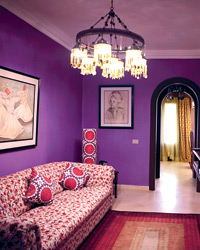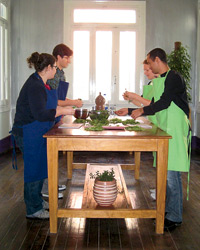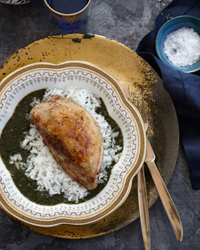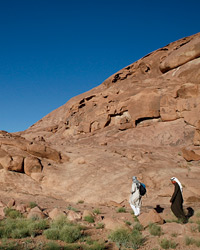My grandmother Alyce was famous in our family for the Sunday lunches she’d cook in her small town in Lebanon. When she was alive, before my parents and I came to live in America, I was too young and rowdy to pay close attention to all the meze dishes, grilled meats, stews and salads on her table. But I do remember one dish, molokhia, vividly. It was dark green and soupy, and I wanted no part of it. I knew one thing about it, though: It was Egyptian.
It would be a few years before I would begin to like molokhia, by which I mean fall madly in love with it. It has layers of cinnamon-scented chicken and buttery rice surrounded by a wonderful sauce of dark, bittersweet greens—an adult-looking dish, to be sure. Even though the Lebanese consider it a staple, they’ll generally concede credit for it to the Egyptians. Molokhia, which means “of the kings,” is what first put Egypt on my radar, well before I’d learned much else about the country.
Of course, politics, not food, has turned the world’s attention to Egypt since the 2011 uprising that toppled Hosni Mubarak from an almost-30-year dictatorship, and the subsequent struggle over the post-revolutionary leadership. It has been a tumultuous year, no doubt about it, and as the country continues to undergo all kinds of changes (parliamentary elections, a new constitution), the world is watching. I hope that once the headlines die down, one positive result of all the eyes on Egypt will be a renewed interest in the country’s history and culture, including its fascinating and little-known culinary traditions.
 Le Riad, a chic, all-suites boutique hotel located in Cairo’s oldest quarter. Photo © David Degner.
Le Riad, a chic, all-suites boutique hotel located in Cairo’s oldest quarter. Photo © David Degner.On a recent trip to Egypt between episodes of unrest, I made a point of spending time exploring the country’s food. My reintroduction to the cuisine began one sunny morning in Cairo, at the 14th-century Khan El Khalili souk. After peeks into the ancient market’s many textile and spice shops, my guide, Lamia El Tawdy, took me to a vendor to try a sandwich of ful, fava beans stewed in olive oil and garlic. I’ve eaten ful medammes, ubiquitous around the Middle East, my whole life, but never quite like this. The warm, soft, olive oil-laden fava beans were ladled into folds of Egyptian bread—bouncy, stretchy, tasting of whole-grain wheat and so unlike the Arabic pita I knew. My guide saw me smile and said, “If you see someone looking completely at peace, you know they’ve just eaten ful.”
I was staying at Le Riad, a stylish little hotel near the souk. My room, the King Farouk Suite, was named after Egypt’s deposed ex-monarch. As I settled in later that day, I browsed through an August 1952 issue of Paris Match left out on the coffee table. It showed a photo spread of the former king, who, after getting toppled in the revolution just a month before, was lounging in Capri with his family, bored in exile.
For dinner that night, my mind was focused less on the country’s fallen regimes than on its food. I learned that it takes some effort to hunt down good Egyptian-cuisine restaurants in Cairo. My contact in the city, Eric Monkaba, a cool-tempered, impeccably dressed 31-year-old of Syrian heritage who grew up in Michigan, took me to a place he loves called Abou El Sid. Four years ago, Monkaba launched a Cairo-based travel-planning company called Backpacker Concierge, which I’d hired to help arrange guides and hotels. More recently, he and Hossam El Sherbiny opened a Cairo cooking school called Qasr Twenty, reportedly the first in the city to specialize in Egyptian dishes.
At Abou El Sid, a cacophonous, banquette-lined restaurant, I was happy to discover stuffed pigeon, an Egyptian specialty since the time of the pharaohs. The two small birds arrived elegantly displayed side by side, dark pink and juicy inside, with crisp caramelized skin and a stuffing made of the roasted cracked wheat called freekeh. Next came a fragrant bowl of koshary, more comfort food than royal-banquet star. It’s made with two key Egyptian ingredients, lentils and chickpeas, layered in a bowl with rice, macaroni and fried onion. I took my cue from others around me, mixing the ingredients together and drizzling on a tomatoey hot sauce. An absolute carb-fest, loaded with crunch, sauciness and spice. How had I never heard of it before?
I asked Monkaba why he thinks Egyptian cuisine is less known around the world than, say, Moroccan or Lebanese. “The French brought back new flavors and dishes from their colonies to their home country, and to the world, but French occupation of Morocco and Lebanon penetrated more deeply than it did in Egypt,” he explained. “Also, the British were in Egypt significantly longer than the French but never managed to incorporate themselves into the culture, and it’s no surprise they exported nothing of the cuisine.”
 Travelers learn how to cook Egyptian food at Qasr Twenty. Photo © David Degner.
Travelers learn how to cook Egyptian food at Qasr Twenty. Photo © David Degner.Qasr Twenty aims to bring Egyptian food back from obscurity. The school is on the second floor of a 1930s Art Deco building, with each room painted a different shade—purple, gold, green. Light flooded in through arched windows and balconies as the staff, skilled Cairo chefs and home cooks, set out ingredients. In Egypt, molokhia is often made with rabbit, but we were going to make it with chicken, the way I’d always known it in Lebanon. The dish has a sauce of Jew’s mallow leaves, grown all over the Middle East. I learned that I needed to mince the leaves very finely, until they reached an almost elastic consistency. I helped prepare the broth to boil the chicken, then browned the meat in butter. Then we cooked the greens in the chicken broth. “Never let them come to a boil!” an instructor called out to me. We stirred in a paste of mashed garlic cloves and ground coriander. I’d never made molokhia before, perhaps afraid mine wouldn’t live up to my grandmother’s, and I felt lucky to have this hands-on training.
As it simmered, we started the shorbet ads, or lentil soup. I loved the red-orange color the soup developed as we simmered the red lentils with fiery-hued tomatoes and carrots. We passed the soup through a strainer, pressing down hard to make a puree (a blender would work, too), then spiced the soup with cumin and chile. We made Arabic-style croutons to sprinkle on top, tearing pieces of pita bread and frying them until they became crunchy-hot.
“Egyptian cuisine needs to be more appreciated,” El Sherbiny said as he, Monkaba and I ate a lunch of dishes made in class. One of the staff chimed in from the kitchen: “Lebanese food is more famous, but it’s mostly appetizers.” Whoa! I had to pipe up: “Lebanese cuisine goes far beyond meze,” I said defensively, enjoying the sparring match. But point taken about Egyptian food.
After lunch, Monkaba had arranged for me to go to Alexandria, three hours away by car. When my taxi rolled into the ancient port city, along the dazzling Mediterranean waterfront, I felt a rush. I emerged onto a graceful, park-like square filled with palm trees and fronting the shoreside boulevard, which curls around the coast and seems to stretch out endlessly into the past and future.
I boarded a tram and rode through the dense downtown, packed with tiny old shops and rows of 19th-century Italianate buildings, on the way to dinner with Monkaba and a local guide. The sprawling Ibn El Balad restaurant, crowded with enormous family-size tables and towering stone columns, has been a hit with Alexandrians since it opened a few years ago. I sampled the molokhia as well as ruqaq (buttery, crackling phyllo squares filled with slightly sweet spiced beef) and mumbar (small, luscious chitterlings flavored with cardamom). I wished Egyptian-cuisine restaurants like this one were more ubiquitous.
I planned to end my trip to Egypt with the Bedouins in the Sinai mountains. From Cairo I flew into Sharm El Sheikh airport, on the Red Sea coast, and took a one-and-a-half hour taxi ride to Dahab—one of those remote seaside towns where beach bums from around the world come to windsurf and end up staying months, years, a lifetime.
Monkaba had hired a Bedouin guide to meet me for a trek in the St. Katherine Protectorate, a desert-and-mountain ecosystem two hours by car from Dahab, and he’d arranged for members of the Bedouin Jebalia tribe to cook me lunch in their tent. In the car, I stared at the rocky red mountains as the driver stopped to let camels cross the road. My guide and I hiked up the dry, stony, craggy-edged slopes, dotted with hardy mulberry and carob trees.
When we arrived at the tent, only about three yards square and made of goat hair, I introduced myself to the small group in Lebanese-dialect Arabic—a workable if spotty substitute for Egyptian Arabic—and sat quietly, watching an elderly woman from the tribe and her 10-year-old niece grind wheat. A few neighbors from the tribe, wearing the long-sleeved cotton gowns and turbans Bedouins prefer to keep the sun and sand off their skin, dropped by to chat and lounge on the floor cushions as they discussed a friend’s upcoming wedding.
Lunch was impressive: focaccia-like bread baked in a stone oven in the tent and made from wheat I’d helped grind on a round stone mill; a soothing wheat porridge called jerisha, flavored with tart fermented goat milk; a salad of girgir (arugula), onions and tomatoes, grown in an irrigated garden nearby and sprinkled with lemon and rock salt from mountain caves; and a lively soup made from dried tomatoes, chard and zucchini. The ingredients were all grown or foraged in the harsh desert climate, but the dishes were fresh-tasting and vibrant and prepared with skill, more a finely honed craft than just a means of sustenance.
It’s been a little over a year since Egypt’s revolution, and it’s not clear yet what change will bring. But on a light, optimistic note, Monkaba and his team are planning to launch new culinary trips around the country—the first are slated for later this year—including cooking classes, a wine tour, a jam-making demo and a day spent learning Bedouin recipes in the St. Katherine Protectorate. The Cairo cooking school also happens to be a short walk from Tahrir Square, headquarters of the revolution and now—no surprise—the latest must-see for anyone who wants to understand the new Egypt.
Here, some highlights from writer Salma Abdelnour’s Egyptian food trip. She worked mainly with Backpacker Concierge, which creates individualized tours of Jordan and Egypt (backpackerconcierge.com).
 Molokhia with Spiced Chicken. Photo © Petrina Tinslay.
Molokhia with Spiced Chicken. Photo © Petrina Tinslay.Le Riad
In Cairo, a stylish boutique hotel with 17 suites and a great location just outside the Khan El Khalili souk. Suites from $323; leriad-hotel decharme.com.
Abou El Sid
One of the best restaurants in Cairo for authentic Egyptian food, served in a loud, banquette-lined dining room. 157 26th of July St.; Zamalek; 011- 202-2735-9640.
Ibn El Balad
A popular restaurant in Alexandria with Egyptian dishes like ruqaq—phyllo squares filled with spiced beef. Mostafa Kamel St. (behind El Salam Theater); 011-203-541-1404.
Qasr Twenty
Backpacker Concierge’s Cairo cooking school, specializing in Egyptian classics and located in a 1930s Art Deco building near Tahrir Square. $85 per person; 20 Qasr al Ainy; 011-20- 109-494-1329 or qasrtwenty.com.
Embah Safari
Organizes trips into the Sinai Peninsula to experience Bedouin culture. From $120 per person for a two-day trek; embah.com.

Writer Salma Abdelnour travels from city to mountain on her Egyptian food tour. Photo © David Degner.
No comments:
Post a Comment